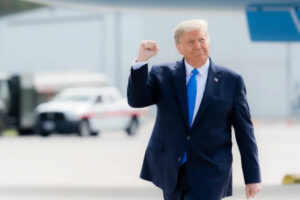Trumping Trump
There were many detractors of former and now incoming President Donald Trump especially on his narrow economic nationalism, restrictive immigration policy, and, well, his boorishness. But on the night after the US election, we received this market report from our friend Jonathan Ravelas saying that Trump trumped Harris. There were five elements in the report: […]

There were many detractors of former and now incoming President Donald Trump especially on his narrow economic nationalism, restrictive immigration policy, and, well, his boorishness. But on the night after the US election, we received this market report from our friend Jonathan Ravelas saying that Trump trumped Harris. There were five elements in the report: Dow futures rallied 900 points to near highest on record; bitcoin surged to $75,000 for the first time in history; the US dollar rose to its highest level since July 2024; the 10-year note yield increased to 4.5% for the first time since June 2024; the volatility index dropped to the lowest level since August 2024; and oil prices sharply retreated to $70/barrel.
Impressive!
But we can’t say for sure whether these market indicators can hold up over the next four years. Trump stood for a political platform that may cause either a disaster for the US economy or, even if ironically, salvation and prosperity to the majority who carried him back to the White House. One thing is certain, that very tight race for the White House turned out to be Trump’s game, and all that remains is his presidential inauguration. Uncertainty has been dimmed from the stage.
On Nov. 6, The ING Group summed it all up, that the American people have spoken and Trump will be the 47th president of the United States. ING’s agenda for the White House included the Federal debt limit which will be reinstated starting Jan. 2 next year. Unless this is lifted or abolished, the Treasury is expected to use “extraordinary measures” to settle the huge federal obligations. This should be a breeze given the impending Republican control of both houses of Congress.
As we know all along, three overriding concerns are expected to be championed by Trump. The first is lower taxation especially for corporates. He will have to extend and modify the Tax Cuts and Jobs Act, which is set to expire next year. The second is to restrict immigration especially from the southern border with Mexico. And finally, to raise tariffs on imports especially from China, and to revive his old call for the re-shoring of production and even the possible recall of business process outsourcing.
But it would be useful to check some formal assessments of Trump’s economic policies, for example, the research done by Warwick J. McKibbin, Megan Hogan, and Marcus Noland of the Peterson Institute for International Economics (PIIE). Writing last month, these researchers quoted Trump saying that if elected, he promised to improve Americans’ lives presumably under the banner “Make America Great Again” (MAGA). But the policies he intended to implement upon election may not actually promote the very goals of public policy Trump wishes to achieve. The research included such policies as deporting millions of people from the United States, steeper tariffs, and eroding the Federal Reserve’s political independence.
PIIE argued that these policies could in fact bring US growth and employment down but inflation up. Some of the possible effects could be reversed shortly, but for the other effects, the damage could be protracted until 2040.
Two scenarios were drawn up by the PIIE researchers.
The low scenario involves a 60 percentage point increase in tariffs on US imports from China and a 10 percentage point increase in tariffs on all other imports. Retaliation by other countries by way of higher tariffs on imports from the US is ruled out in this scenario. Some 1.3 million workers are deported while the President gets to influence the US Fed decisions.
The high scenario is deadly: with the same tariff adjustments, the trading partners retaliate. The US is to deport 8.3 million workers, while the US Fed’s independence is undermined by the White House.
What are the possible results under these two scenarios?
In both scenarios, PIIE estimated that US real GDP could grow between 2.8% and 9.7% lower than the baseline by the end of Trump’s four-year term in 2028. In US dollars, it means the US will be losing between $750 billion to $2.57 trillion below the baseline. There could be some bit of a recovery but still lower than what is seen in 2040 or between 1.5% and 6.6% lower than the baseline. Output loss is expected to affect both agriculture and manufacturing.
A double whammy it is for the American people, for aside from lower growth and less job opportunities, higher inflation awaits them, too. By 2026, inflation is projected to be higher by 4.1 and 7.4 percentage points than the baseline of 1.9% or between 6% and 9.3%. By 2028, US consumer prices are expected by PIIE to reach 20% and 28% higher which means inflation could reach 2 percentage points higher than baseline, or nearly 4% from 2034 through 2040.
Therein lie the possible trump cards. As the PIIE researchers concluded: “Trump proposes to help Americans through policies of mass deportations, trade protection, and greater presidential influence over the Fed. But these policies over time would leave the US economy generally worse off than if he did not enact them.” These could trump Trump in his four years in office even as he is no longer qualified for reelection. But he could make a difference if governance is made right and public ownership of government policy is made strong. This is expected of Trump in his second encounter with the American people.
As quoted by ING, the bipartisan Committee for a Responsible Federal Budget estimated that Trump’s policy mix of tax cuts, tariff hikes, and higher spending could add $7.75 trillion to the US national debt in the next 10 years relative to the baseline scenario. Like here in the Philippines, their public debt has bloated because of the sustained increases in their fiscal deficit which at the last account stood at an enormous 7% of GDP. That should send jitters to US creditors, those who buy their Treasuries, driving borrowing costs higher in the US economy. This could constrict growth and employment.
Unfortunately, this is a signal for the US Fed to be more cautious on monetary policy unless the White House starts to wield the trump card over the monetary authorities. In that case politics and fiscal policy trump monetary policy.
Trump’s China containment policy could be strategically important for Southeast Asia, especially for the Philippines and its neighboring countries. They have all indicated their respective claims over parts of the South China Sea and they include Indonesia, Malaysia, and Vietnam, all of which defied Chinese bullying in recent times. In Europe, he will likely insist on burden-sharing with the NATO members in order to help shore up America’s public finance.
What Trump will do with respect to at least two wars in progress remains uncertain. The Ukraine-Russia war may be resolved in favor of Russia as he might decide to withdraw military support of Ukraine. If he succeeds in brokering peace in the Middle East, this might still be fragile if the US is perceived to be vacillating. One thing is certain at this point.
Americans indeed dismissed warnings that Trump is a threat to their way of life. He was not “chaos and division” but he represented an option to diminished economic prospects for them. Rather, for one retiree Mary Chastain, 74, who voted for Trump, it is “electric, water, groceries, my dues for where I live — everything has gone up” (New York Times, Nov. 6, 2024) even as the economy has remained resilient and inflation is coming down. High-minded talk about failure of institutions, about democracy and constitutional rights did not seem to register with the so-called red states.
True, Vice-President Kamala Harris considered Trump as an outlier in her closing rally prior to the Nov. 5 election, “That is not who we are.” But as Peter Baker of the New York Times observed, it turned out Trump “may be exactly who we are. At least most of us.” While offending a lot of Americans for his anger and unorthodoxy, they found Trump authentic. But if Trump trumped himself during his first time in the White House, his second chance as a convicted criminal, one who questioned constitutional processes like national elections, and simply reenact his playbook in the next four years, God bless America! That would be Trump II. Without doubt, Trump has a choice, and that is not to trump himself.
Diwa C. Guinigundo is the former deputy governor for the Monetary and Economics Sector, the Bangko Sentral ng Pilipinas (BSP). He served the BSP for 41 years. In 2001-2003, he was alternate executive director at the International Monetary Fund in Washington, DC. He is the senior pastor of the Fullness of Christ International Ministries in Mandaluyong.























